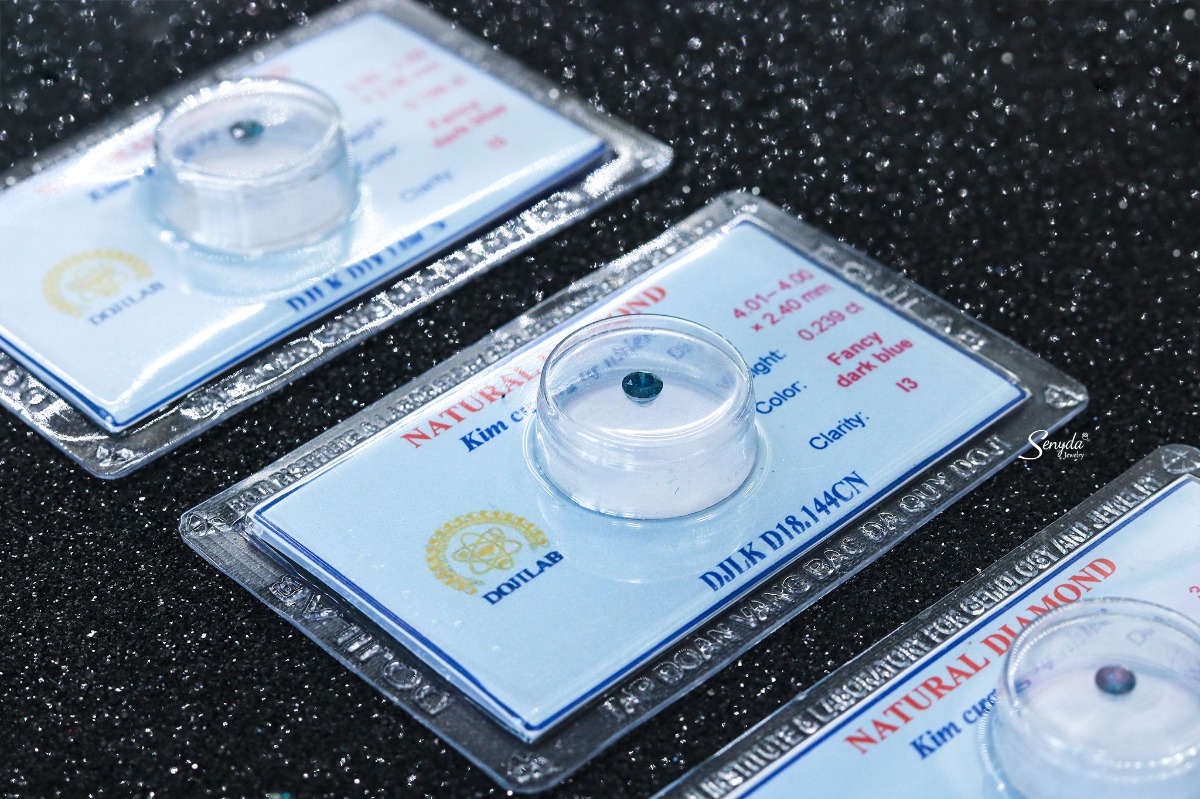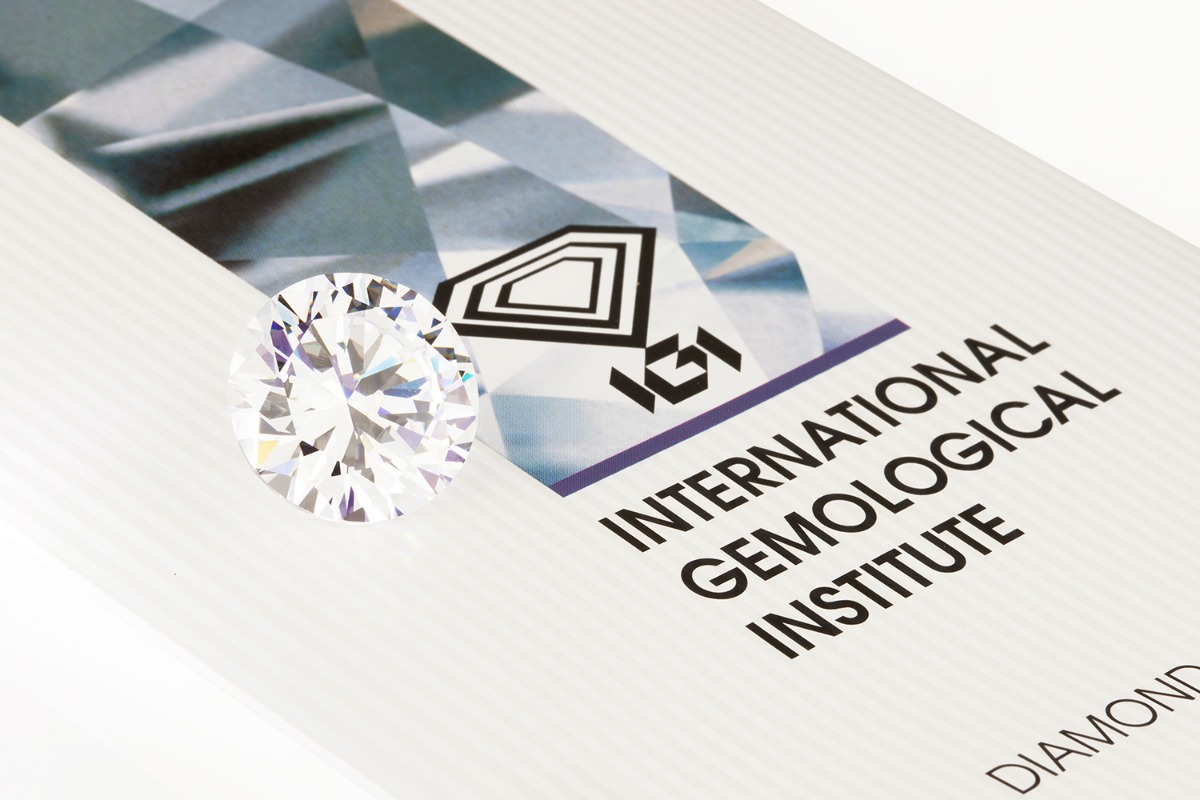In the dazzling world of diamonds, brilliance isn't just about sparkle, it's about trust. That trust begins with a diamond certification, the official report that reveals the true identity of your gemstone. But with names like GIA, IGI, and HRD thrown around, how do you know which certification holds the most weight? In this blog post, we decode the leading diamond grading labs and help you navigate what those certificates mean, beyond the carats and clarity.
1. What is diamond certification?
Diamond certification (also known as a Diamond Grading Report) is an official document issued by independent gemological laboratories such as GIA, IGI, or HRD. This certificate verifies the authenticity, quality, rarity, and true value of a diamond based on the internationally recognized 4Cs grading system: Carat (weight), Color, Clarity, and Cut. Think of it as the diamond's “birth certificate” — a reliable proof of what you’re purchasing or investing in.

Diamond certification explained: GIA, IGI, HRD & more
1.1. Why is diamond certification essential when buying?
According to a GIA study, nearly 70% of uncertified diamonds are overpriced by 20–50% compared to their actual quality. Without a valid diamond certification, buyers are more vulnerable to overpaying for diamonds that may look stunning but fail to meet advertised standards.
Moreover, certifications play a critical role in distinguishing real diamonds from fakes. Reputable certificates from GIA, HRD, or IGI can detect common fraud tactics such as heat treatment, clarity enhancement, or the use of Moissanite (a diamond simulant). For example, in 2023, a 2-carat diamond in Vietnam was identified as fake Moissanite thanks to a GIA certificate number check, saving the buyer from a potential loss of over 8 billion VND.

Diamond certification explained: GIA, IGI, HRD & more
1.2. The "golden" value of diamond certification in pricing
Each diamond is evaluated using high-precision tools such as spectrometers and 10x magnification microscopes, ensuring an objective and unbiased grading independent of seller opinion.
Beyond quality assurance, diamond certification also holds legal value, serving as valid proof in asset appraisal, insurance claims, or legal disputes. Most importantly, GIA-certified diamonds can retain 2–3 times more resale value than uncertified stones, according to Bloomberg.
To illustrate, a 1-carat GIA-certified diamond graded D/IF (flawless and colorless) can be up to 30 times more expensive than a similarly sized diamond with a J/SI2 grade (lower color and clarity) — and that premium is solely justified by the certification.


Diamond certification explained: GIA, IGI, HRD & more
2. Overview of the most trusted diamond certification organizations today
When exploring the world of diamond certification, three organizations currently stand out as the most trusted globally: GIA, IGI, and HRD. Each institution follows its own grading system and evaluation criteria, playing a vital role in defining the true value of the diamond you own or plan to invest in. Understanding the differences between these diamond grading labs helps buyers make informed and confident decisions when choosing a certified diamond.
2.1. GIA (Gemological Institute of America)
GIA is a nonprofit gemological institute headquartered in the United States, founded in 1931. It is widely recognized as the pioneer behind the 4Cs grading system (Cut, Color, Clarity, and Carat Weight), which has become the global standard in diamond evaluation.
GIA follows a highly strict and consistent grading process. It utilizes advanced technology such as UV-Vis spectrophotometers, 10x magnification microscopes, and laser measuring tools to assess every detail of a diamond. Each stone is examined by at least three independent gemologists to ensure exceptional accuracy. According to its 2023 report, the margin of error in GIA diamond grading is as low as 0.01%.
A GIA-certified diamond not only ensures transparency and authenticity but also increases its market value by 30–50% compared to uncertified stones. GIA certificates are trusted by renowned international auction houses such as Sotheby’s and Christie’s, making GIA the gold standard for those investing in diamonds or purchasing high-end jewelry for long-term value.


Diamond certification explained: GIA, IGI, HRD & more
2.2. IGI (International Gemological Institute)
IGI is the world’s largest independent diamond certification institute, headquartered in Belgium, with more than 20 laboratories across over 10 countries. It is particularly popular in major Asian markets such as India and China, as well as across Europe. The IGI certificate is favored by large-scale jewelry manufacturers thanks to its fast turnaround time and cost-effective grading services.
Compared to GIA, IGI offers more flexibility in color grading (with potential variation of 1–2 color grades) and is also a leading authority in certifying lab-grown diamonds. IGI grading reports are usually issued within 3–5 days, with multilingual support and approximately 20–30% lower costs than GIA.
However, IGI has faced criticism over grading consistency. Studies show that around 15% of diamonds graded by IGI receive different ratings when re-evaluated by GIA. Despite this, IGI remains a practical option for budget-conscious buyers who need quick certification, especially in the lab-grown diamond market.


Diamond certification explained: GIA, IGI, HRD & more
2.3. HRD (Hoge Raad voor Diamant)
HRD, based in Antwerp, Belgium—a city known as the diamond capital of the world for over 500 years—is widely respected across Europe. It is especially trusted among royal families in Belgium and the Netherlands and is highly rated by the World Federation of Diamond Bourses (WFDB).
The HRD diamond certificate is unique in several ways. It uses a proprietary color grading scale from D to K and evaluates light performance using specialized 3D software. HRD also issues digital certificates embedded with encrypted codes to prevent counterfeiting.
Known for its detailed reporting and luxurious presentation, HRD certification is often preferred for high-end diamond jewelry and exclusive collections tailored to the European market.

Diamond certification explained: GIA, IGI, HRD & more
3. Other notable diamond certification organizations you should know
3.1. AGS (American Gem Society)
Founded in 1934 in the United States, the American Gem Society (AGS) is a respected authority known for its specialization in diamond cut grading. AGS uses a unique grading scale from 0 (Ideal) to 10 (Poor), placing a strong emphasis on optical precision and light performance.
AGS certification is highly regarded by high-end jewelry retailers in the U.S., especially when showcasing the brilliance and cut quality of a diamond, two key factors that influence sparkle. However, AGS has a more limited global reach compared to GIA or IGI.

Diamond certification explained: GIA, IGI, HRD & more
3.2. EGL (European Gemological Laboratory)
The European Gemological Laboratory (EGL) is a network of gem labs originally established in Europe and now operating in several countries. It became popular due to its lower certification costs and faster turnaround times. However, EGL has faced controversy due to inconsistencies and more lenient grading standards, especially when compared to GIA.
Because of grading discrepancies among branches (such as EGL USA and EGL International), the organization has lost credibility in the U.S. market. Many auction houses now reject EGL-certified diamonds, so consumers should exercise caution.

Diamond certification explained: GIA, IGI, HRD & more
3.3. NGTC (National Gemstone Testing Center)
Based in China, the National Gemstone Testing Center (NGTC) is a government-backed institution widely used across domestic and Asian markets, including Singapore and Malaysia. NGTC offers diamond certification by Chinese national standards and provides documentation in multiple languages, especially Mandarin.
While NGTC is widely accepted for local transactions, it lacks global recognition, making it less suitable for international investment or resale.
3.4. CGL (Central Gem Laboratory)
Founded in 1970, Japan’s Central Gem Laboratory (CGL) is a leading authority in the country’s gemstone evaluation field. CGL has a strict grading system that focuses on clarity and color, in line with Japanese standards. CGL-certified diamonds are commonly found in Japan and South Korea, especially in retail transactions.
However, CGL certificates are not as internationally recognized as those from GIA or IGI, limiting their global resale potential.
3.5. Gübelin Gem Lab & SSEF – For high-end and collectible gemstones
Gübelin Gem Lab (Switzerland) and SSEF (Swiss Gemological Institute) are two of the most prestigious gemological laboratories in Europe. They specialize in certifying rare and high-value gemstones, including collectible diamonds.
Gübelin is renowned for its advanced origin-tracing technology, frequently used for rubies, sapphires, and investment-grade diamonds. SSEF provides highly detailed reports that include spectroscopy analysis, 3D imaging, and geographic origin confirmation.
Both labs are trusted by elite collectors and top-tier auction houses like Christie’s and Sotheby’s. However, their services are costly and time-consuming, making them less practical for everyday diamond purchases.
Choosing a diamond isn’t just about beauty — it’s about assurance. And that assurance begins with a trusted diamond certification. Now that you’ve explored the differences between GIA, IGI, HRD, and other grading authorities, you’re equipped to look beyond the sparkle and into the soul of the stone. Whether you're buying for love, investment, or legacy, understanding diamond certification empowers you to make smarter, safer decisions. Because in the end, a diamond’s true value lies not only in how it shines, but in how it's certified.
